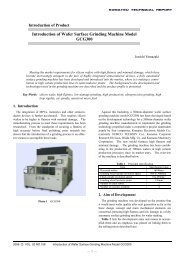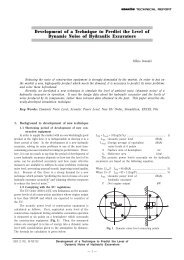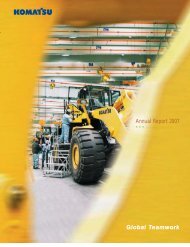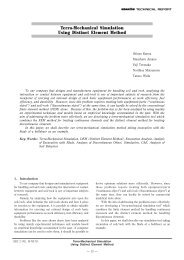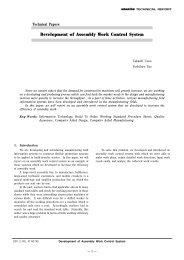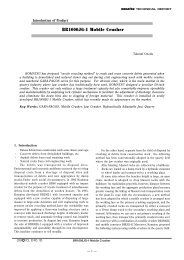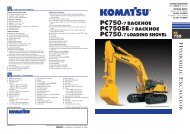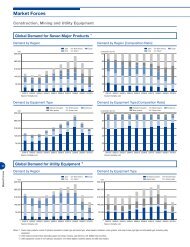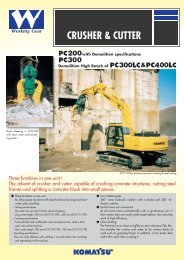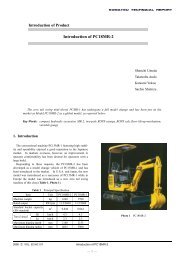Introduction of Hydrostatic Transmission Forklift Model ... - Komatsu
Introduction of Hydrostatic Transmission Forklift Model ... - Komatsu
Introduction of Hydrostatic Transmission Forklift Model ... - Komatsu
Create successful ePaper yourself
Turn your PDF publications into a flip-book with our unique Google optimized e-Paper software.
<strong>Introduction</strong> <strong>of</strong> Products<br />
<strong>Introduction</strong> <strong>of</strong> <strong>Hydrostatic</strong> <strong>Transmission</strong> <strong>Forklift</strong> <strong>Model</strong><br />
FH40-1/FH45-1/FH50-1<br />
Hiroyuki Yamamoto<br />
Yasuo Harada<br />
Hideyuki Hiraiwa<br />
The 4-ton class engine powered forklift truck, FH series FH40/45/50-1, have been developed and introduced<br />
into the market as <strong>Komatsu</strong>’s first forklift truck installed electronic controlled HST (<strong>Hydrostatic</strong> <strong>Transmission</strong>)<br />
and variable pump CLSS (closed-center load sensing system). New technologies and outline <strong>of</strong> the improvement<br />
for fuel efficiency in the new models are introduced.<br />
Key Words: <strong>Forklift</strong>, HST, <strong>Hydrostatic</strong> <strong>Transmission</strong>, CLSS, Closed Center Load Sensing System, Low Fuel<br />
Consumption, Environment, Safety, ICT<br />
1. <strong>Introduction</strong><br />
In recent years, needs for low fuel consumption and<br />
reduction in environmental loads have rapidly increased in<br />
industrial vehicles and construction machinery due to growing<br />
global environmental awareness and a rise in crude oil prices.<br />
The response to the above has become an important element<br />
in the development and manufacturing <strong>of</strong> forklifts.<br />
Introduced below is the outline <strong>of</strong> a new hydrostatic<br />
transmission forklift model “FH Series” (Fig. 1, Table 1)<br />
which has adopted electronically-controlled HST (<strong>Hydrostatic</strong><br />
<strong>Transmission</strong>) in place <strong>of</strong> T/C (Torque Converter) + T/M<br />
(<strong>Transmission</strong>) used for travel drive system <strong>of</strong> conventional<br />
forklifts, has realized low fuel consumption and reduction in<br />
environmental loads, has improved operability and has been<br />
introduced to the market this time.<br />
Fig. 1 External view photo <strong>of</strong> FH50-1<br />
2012 VOL. 58 NO.165 <strong>Introduction</strong> <strong>of</strong> <strong>Hydrostatic</strong> <strong>Transmission</strong> <strong>Forklift</strong> <strong>Model</strong> FH40-1/FH45-1/FH50-1<br />
― 1 ―
Performance and dimensions<br />
Item<br />
Table 1 Major Specifications<br />
Unit<br />
Developed<br />
model<br />
FH50-1<br />
Current<br />
model<br />
FD50AT-10<br />
Maximum load kg 5000 5000<br />
Load center mm 600 600<br />
Maximum travel speed km/h 23. 5 25<br />
Wheelbase mm 2000 2000<br />
Tread Front/Rear mm 1225/1120 1150/1120<br />
Machine mass kg 7380 7295<br />
Manufacturer - <strong>Komatsu</strong> <strong>Komatsu</strong><br />
<strong>Model</strong> name - SAA4D95LE SAA4D95LE<br />
Engine<br />
No. <strong>of</strong> cylinders / Total displacement -/cc 4/3260 4/3260<br />
Rated output kW/rpm 50.8/2150 59.7/2400<br />
Fuel tank capacity L 105 98<br />
Information ICT - KOMTRAX -<br />
2. Development Objectives and Means <strong>of</strong><br />
Achievement<br />
(1) Reduction in fuel consumption<br />
Reduction in power transmission loss thanks to the<br />
electronically-controlled HST<br />
Realization <strong>of</strong> low fuel consumption in high load work by<br />
controlling engine output in accordance with cargo weight<br />
Reduction in oil pressure loss during simultaneous<br />
operation <strong>of</strong> load handling system and travel drive system<br />
thanks to CLSS + variable pump<br />
(2) Improvement in operability and workability<br />
Travel operation has become easier than that <strong>of</strong> T/C<br />
forklifts due to the adoption <strong>of</strong> electronically-controlled HST.<br />
Improvement in workability during stopping, hill starting<br />
and switch-back operation<br />
(3) Improvement in safety<br />
Travel speed limiting function as standard equipment<br />
(4) ICT<br />
Installation <strong>of</strong> “KOMTRAX” as standard for the first time<br />
in forklifts<br />
Electronically<br />
controlled HST<br />
ecot3<br />
engine<br />
Variable pump<br />
CLSS<br />
Fig. 2 General view <strong>of</strong> FH50-1<br />
3. Main Components<br />
Our unique hydraulic system “electronically-controlled<br />
HST”, which has been well proven in wheel loaders and<br />
bulldozers, has been installed in the travel drive system while<br />
“variable pump and CLSS” adopted for excavators has been<br />
installed in the load handling system.<br />
The reliability and productivity have been enhanced by<br />
developing and manufacturing main components in-house,<br />
utilizing technologies nurtured through construction<br />
machinery including commonrail electronically-controlled<br />
diesel engines and machine body controller.<br />
2012 VOL. 58 NO.165 <strong>Introduction</strong> <strong>of</strong> <strong>Hydrostatic</strong> <strong>Transmission</strong> <strong>Forklift</strong> <strong>Model</strong> FH40-1/FH45-1/FH50-1<br />
― 2 ―
Variable pump for<br />
load handling<br />
system<br />
4. Outline <strong>of</strong> System<br />
Fig. 3 Main components<br />
4.1 Conventional forklift (with torque<br />
converter)<br />
The structure <strong>of</strong> a general, conventional T/C forklift is<br />
shown in Fig. 4.<br />
The clutch is attached to the output shaft <strong>of</strong> the<br />
transmission and when the inching pedal is depressed, power<br />
is shut <strong>of</strong>f. If you want to travel forward slowly while<br />
operating the load handling system fast (simultaneous<br />
operation <strong>of</strong> load handling and travel), depress the accelerator<br />
pedal to increase engine speed and adjust clutch slip with the<br />
inching pedal to control the travel speed.<br />
Conventional forklift (T/C forklift)<br />
Commonrail<br />
electronicallycontrolled<br />
engine<br />
Inching<br />
pedal<br />
HST hydraulic<br />
pump<br />
HST hydraulic<br />
motor<br />
Accelerator<br />
pedal<br />
4.2 New FH Series forklift (with HST)<br />
The system structure <strong>of</strong> the new “FH Series” HST forklift<br />
is shown in Fig. 5.<br />
The engine rotates the pump to produce oil pressure, which<br />
is converted again to turning force with the motor. A flow rate<br />
<strong>of</strong> hydraulic oil is continuously increased or decreased by<br />
changing the angle <strong>of</strong> the swash plate connected to the pistons<br />
to change the piston stroke. This swash plate angle control<br />
realizes the stepless speed control from forward travel, stop to<br />
reversing. When the swash plate is moved to the neutral<br />
position, the piston stroke stops, producing the same effect as<br />
the application <strong>of</strong> the brake.<br />
When the inching pedal is depressed, the HST pump swash<br />
plate moves to the neutral position and the machine stops.<br />
During simultaneous operation <strong>of</strong> load handling and travel,<br />
depress the accelerator pedal to increase engine speed, change<br />
a HST pump capacity control signal from the controller with<br />
the inching pedal and adjust the swash plate angle (oil<br />
quantity) to control the travel speed.<br />
A variable pump is used also for the hydraulic system <strong>of</strong><br />
load handling system and supplies only a necessary quantity<br />
<strong>of</strong> oil with a signal from the operating valve.<br />
HST forklift<br />
Differential<br />
Motor<br />
Pump<br />
Inching<br />
pedal<br />
Controller<br />
Engine<br />
Accelerator<br />
pedal<br />
<strong>Transmission</strong><br />
Tire<br />
Swash plate<br />
Differential<br />
Torque converter<br />
Engine<br />
Load handling system<br />
Pressure<br />
sensor<br />
Operating<br />
lever<br />
Operating<br />
valve<br />
Variable pump<br />
Tire<br />
Clutch<br />
Operating<br />
lever<br />
Operating<br />
valve<br />
Load handling system<br />
Gear pump<br />
Fig. 4 System structure chart <strong>of</strong> general conventional forklift<br />
(T/C forklift)<br />
In general, a gear pump is used for the hydraulic system <strong>of</strong><br />
the load handling system, and because it is a fixed capacity<br />
type pump, a constant oil quantity is supplied according to<br />
engine speed regardless <strong>of</strong> the operation <strong>of</strong> load handling<br />
system.<br />
Fig. 5 System structure chart <strong>of</strong> HST forklift<br />
5. Reduced Fuel Consumption<br />
5.1 Usage <strong>of</strong> forklift<br />
<strong>Forklift</strong>s are <strong>of</strong>ten operated in a limited place, and<br />
acceleration and stop (with change in travel direction, forward<br />
and backward), and simultaneous operation <strong>of</strong> load handling<br />
and travel are frequently performed. This type <strong>of</strong> usage is<br />
more remarkable in a worksite with higher load and higher<br />
rate <strong>of</strong> operation. As such condition also makes the fuel<br />
consumption larger, users have a keen interest in fuel<br />
consumption reduction. In consideration <strong>of</strong> such worksites<br />
2012 VOL. 58 NO.165 <strong>Introduction</strong> <strong>of</strong> <strong>Hydrostatic</strong> <strong>Transmission</strong> <strong>Forklift</strong> <strong>Model</strong> FH40-1/FH45-1/FH50-1<br />
― 3 ―
where fuel consumption reduction has a large merit to<br />
customers, the following fuel consumption reduction<br />
technologies have been incorporated.<br />
5.2 Technology to reduce fuel consumption<br />
(1) Reduction in heating loss and slip loss by HST<br />
In simultaneous operation <strong>of</strong> load handling and travel <strong>of</strong> a<br />
T/C forklift, clutch slip loss and heating loss are produced<br />
because speed control is performed by controlling the clutch<br />
slip with the inching pedal. (Fig. 4)<br />
On the other hand, on a HST forklift, the travel speed is<br />
controlled by changing the pump swash plate angle to reduce<br />
the oil flow rate instead <strong>of</strong> slipping the clutch. Therefore,<br />
heating loss and slip loss are not produced, resulting in fuel<br />
consumption reduction. (Fig. 5)<br />
that near engine rated speed.<br />
The matching point <strong>of</strong> HST pump absorption torque with<br />
respect to the engine has been set near the maximum torque as<br />
compared with that for the torque converter. This allows for<br />
long use <strong>of</strong> the range where the fuel consumption rate is small<br />
to the extent possible during acceleration, leading to fuel<br />
consumption reduction. ((4) in Fig. 7)<br />
(5) Switching <strong>of</strong> engine torque curve under no load<br />
On a forklift, the machine body weight difference is large<br />
between when it has a load (under load) and when it does not<br />
have a load (under no load). To suppress needless acceleration<br />
under no load, a sensor detects weight <strong>of</strong> a load and when the<br />
load is light, engine output is suppressed, which leads to fuel<br />
consumption reduction. ((5) in Fig. 7)<br />
(2) High efficiency in low travel speed zone<br />
In a torque converter (3 elements, 1 stage, dual phase type)<br />
used generally for forklifts, efficiency in the high travel speed<br />
zone is high due to a free wheel, but efficiency is worse than<br />
that <strong>of</strong> HST in the low travel speed zone due to large churning<br />
loss. (Fig. 6)<br />
Therefore, on a HST forklift, control is performed to<br />
suppress the rev-up <strong>of</strong> engine while improving the<br />
Torque [Nm]<br />
(5)<br />
Conventional forklift<br />
HST forklift<br />
Load<br />
No load<br />
(4)<br />
(3)<br />
acceleration performance, reducing fuel consumption during<br />
acceleration without changing traveling performance.<br />
Equivalent fuel<br />
consumption diagram [L/h]<br />
Engine speed [rpm]<br />
Efficiency<br />
HST<br />
T/C<br />
2-speed<br />
transmission<br />
Speed [km/h]<br />
Fig. 6 Travel efficiency<br />
(3) Optimization <strong>of</strong> engine output<br />
From the above (1) and (2), the engine maximum output<br />
can be reduced by approximately 15% compared to that <strong>of</strong> the<br />
conventional T/C forklift with almost no loss <strong>of</strong> workability,<br />
which results in reduction in fuel consumption. ((3) in Fig. 7)<br />
(4) Low-speed matching<br />
In general, the fuel consumption rate near engine speed<br />
where the maximum torque can be obtained is smaller than<br />
Fig. 7 Matching diagram with engine<br />
(6) CLSS (Closed-center Load Sensing System) + variable<br />
pump system<br />
The CLSS + variable pump system has been installed in our<br />
conventional machines and has contributed to reduction in<br />
fuel consumption.<br />
As a gear pump (fixed capacity) is mainly used for the<br />
hydraulic system <strong>of</strong> the load handling system for general<br />
forklifts, an oil quantity more than necessary is supplied,<br />
which produced large loss.<br />
The CLSS + variable pump system has been adopted for<br />
HST forklifts as with our conventional forklifts. Oil pressure<br />
loss is small because only a necessary quantity <strong>of</strong> oil is<br />
supplied by performing control so that differential pressure<br />
between pump discharge pressure and load pressure <strong>of</strong> each<br />
load handling system is constant when the load handling<br />
system is operated. (Fig. 8)<br />
2012 VOL. 58 NO.165 <strong>Introduction</strong> <strong>of</strong> <strong>Hydrostatic</strong> <strong>Transmission</strong> <strong>Forklift</strong> <strong>Model</strong> FH40-1/FH45-1/FH50-1<br />
― 4 ―
Circuit using fixed<br />
pump<br />
Circuit using variable<br />
pump CLSS<br />
Loss during relief Loss in neutral Loss during fine control<br />
Discharge <strong>of</strong> total quantity Discharge <strong>of</strong> total quantity Discharge <strong>of</strong> total quantity<br />
Required flow rate Required flow rate Required flow rate<br />
Fuel consumption [L/h]<br />
Conventional forklift<br />
HST forklift<br />
Course A Course B Course C<br />
Test<br />
course High load Low load<br />
Reduction effect <strong>of</strong><br />
oil pressure loss<br />
Flow rate<br />
Reduction loss<br />
Pump pressure<br />
Variable pump<br />
Fixed pump<br />
Flow rate<br />
Reduction loss<br />
Pump pressure<br />
Flow rate<br />
Reduction loss<br />
Fig. 8 Reduction effect <strong>of</strong> oil pressure loss <strong>of</strong> load<br />
handling system<br />
Variable pump<br />
Fixed pump<br />
Lever input<br />
Variable pump<br />
Fixed pump<br />
Fig. 9 Result <strong>of</strong> fuel consumption reduction at in-house courses<br />
According to high load user data at a paper mill where HST<br />
forklifts were introduced on a trial basis, a maximum <strong>of</strong> 30%<br />
fuel consumption reduction compared to our conventional<br />
forklifts was accomplished. (Fig. 10)<br />
6. Result<br />
6.1 Reduction in fuel consumption<br />
Fig. 9 shows the fuel consumption reduction effect at<br />
in-house measurement courses.<br />
The fuel reduction effect was obtained in any course. In<br />
particular, the effect <strong>of</strong> no less than 29% was obtained at a<br />
high load course (Course A) where there is a lot <strong>of</strong> switch<br />
back in a short distance assuming loading work to a truck.<br />
Fig. 11 shows the frequency distribution <strong>of</strong> engine speed<br />
and torque at the high load course (Course A). This shows that<br />
as a circle is larger, the frequency is higher. It can be seen that<br />
large circles move to the small fuel consumption side as<br />
compared with those for the conventional forklift. In<br />
particular, HST forklift used the range where there was little<br />
change in engine speed during acceleration and fuel<br />
consumption was small for a long time. Therefore, the result<br />
as intended was obtained.<br />
Fig. 10 Result <strong>of</strong> fuel consumption reduction at user's worksites<br />
Engine torque<br />
Fuel consumption [L/h]<br />
High load user<br />
Paper mill<br />
Conventional forklift<br />
HST forklift<br />
Conventional forklift<br />
HST forklift<br />
Medium load<br />
user<br />
Equivalent fuel<br />
consumption diagram [L/h]<br />
Engine speed [rpm]<br />
Fig. 11 Frequency distribution and fuel consumption<br />
map at high load course<br />
2012 VOL. 58 NO.165 <strong>Introduction</strong> <strong>of</strong> <strong>Hydrostatic</strong> <strong>Transmission</strong> <strong>Forklift</strong> <strong>Model</strong> FH40-1/FH45-1/FH50-1<br />
― 5 ―
Type <strong>of</strong> business in which HST forklift is effective for decreasing fuel consumption (Fig. 12)<br />
Handling business <strong>of</strong> recycled resources (wastepaper)<br />
Handling business <strong>of</strong> timber and woodwork<br />
Bale clamp<br />
Handling business <strong>of</strong> recycled resources (general)<br />
Hinged fork<br />
Handling business <strong>of</strong> concrete secondary product<br />
Hinged bucket<br />
Hinged fork<br />
Fig. 12 Example <strong>of</strong> type <strong>of</strong> business where forklifts are used<br />
6.2 Improvement in operability and<br />
workability<br />
On the electronically-controlled HST, the swash plate is<br />
controlled continuously at the time <strong>of</strong> change between<br />
forward travel and backward travel so that the change can be<br />
performed without a shock without stopping once and with<br />
the accelerator pedal kept depressed. Thus, the brake<br />
operation like conventional forklifts is not required.<br />
In addition, the braking by setting the swash plate in the<br />
neutral position, a characteristic <strong>of</strong> HST, reduces rolling down<br />
<strong>of</strong> the machine on a slope, contributing to the reduction <strong>of</strong><br />
fatigue <strong>of</strong> an operator.<br />
6.3 Safety<br />
The travel speed limiting function is equipped as standard.<br />
The maximum speed can be set to four stages with respect to<br />
the speed control in a limited space, speed limit specified in a<br />
plant, and so on.<br />
6.4 ICT (Information and Communication<br />
Technology)<br />
The machine remote monitoring system “KOMTRAX” has<br />
been installed as standard in forklifts for the first time.<br />
“Visualization” <strong>of</strong> machine information such as the location,<br />
operating condition and fuel consumption has allowed to<br />
support the fleet management with meticulous attention.<br />
7. Conclusion<br />
In cooperation with Power Train Development Center and<br />
Hydraulic Equipment Technical Center, we have realized<br />
commercialization <strong>of</strong> forklifts installed with electronicallycontrolled<br />
HST and CLSS hydraulic system for the first time<br />
as <strong>Komatsu</strong>.<br />
We will continue to make efforts to expand the model<br />
lineup installed with HST and CLSS in the future and at the<br />
same time to aim at further technological leaps to develop<br />
these models to be more attractive to customers.<br />
2012 VOL. 58 NO.165 <strong>Introduction</strong> <strong>of</strong> <strong>Hydrostatic</strong> <strong>Transmission</strong> <strong>Forklift</strong> <strong>Model</strong> FH40-1/FH45-1/FH50-1<br />
― 6 ―
<strong>Introduction</strong> <strong>of</strong> the writers<br />
Hiroyuki Yamamoto<br />
Entered <strong>Komatsu</strong> Ltd. in 1981.<br />
Currently assigned to Technical Center,<br />
Utility Equipment Division<br />
Yasuo Harada<br />
Entered <strong>Komatsu</strong> Ltd. in 1975.<br />
Currently assigned to Technical Center,<br />
Utility Equipment Division<br />
[A few words from writers]<br />
We think we have completed the competitive forklifts by<br />
concentrating the <strong>Komatsu</strong> technologies thanks to the merger <strong>of</strong><br />
the utility equipment businesses in 2011.<br />
We would like to express our deep gratitude to IPA,Hydraulic<br />
Equipment Technical Center,Power Train Development Center,<br />
System Development Center , Test Engineering Center, and<br />
Tochigi Plant and other production departments, not to mention<br />
the customers and distributors who helped our researches.<br />
Hideyuki Hiraiwa<br />
Entered <strong>Komatsu</strong> Ltd. in 1992.<br />
Currently assigned to Technical Center,<br />
Utility Equipment Division<br />
2012 VOL. 58 NO.165 <strong>Introduction</strong> <strong>of</strong> <strong>Hydrostatic</strong> <strong>Transmission</strong> <strong>Forklift</strong> <strong>Model</strong> FH40-1/FH45-1/FH50-1<br />
― 7 ―



